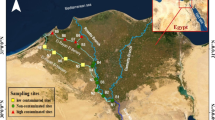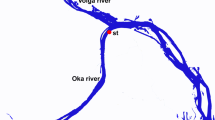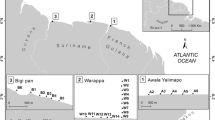Abstract
Tidal creeks are transitional habitats between fresh and salt water with large spatial heterogeneity. As a result there are most likely various microhabitats at different spatial scales. This study attempted to determine at what scales the macrobenthic communities in tidal creeks differ. Samples were collected in headwater, intertidally dominated areas and downstream, subtidally dominated areas of tidal creek habitats at three exposure levels. Samples were analyzed to determine distributions of dominant higher taxa of annelids, crustaceans, and mollusks with particular interest to two dominant species: the oligochaete Monopylephorus rubroniveus (Levinsen) and the polychaete Streblospio benedicti (Webster). Finally, family diversity, evenness, and community composition were examined. While M. rubroniveus was primarily found in intertidal exposures in the headwaters, S. benedicti was found throughout all of the creek lengths and exposure levels. Communities in the marsh appeared to be similar throughout the length of the creek. Communities in the intertidal and subtidal exposure levels differed between the headwaters and downstream areas and between each other in the headwaters. PERMANOVA found communities to differ among all exposure levels and orders. Thus, it is important to take into account both longitudinal position and microhabitat when sampling these communities.




Similar content being viewed by others
References
Anderson, M. J., R. N. Gorley & K. R. Clarke, 2008. PERMANOVA+ for PRIMER: guide to software and statistical methods. PRIMER-E, Plymouth, UK.
Beck, M. W., K. L. Heck Jr., K. W. Able, D. L. Childers, D. B. Eggleston, B. M. Gillanders, B. Halpern, C. G. Hays, K. Hoshino, T. J. Minello, R. J. Orth, P. F. Sheridan & M. P. Weinstein, 2001. The identification, conservation, and management of estuarine and marine nurseries for fish and invertebrates. BioScience 51: 633–641.
Bilkovic, D. M., M. Roggero, C. H. Hershner & K. H. Havens, 2006. Influence of land use on macrobenthic communities in nearshore estuarine habitats. Estuaries and Coasts 29: 1185–1195.
Clark, K. R. & R. N. Gorley, 2006. PRIMER v6: user manual/tutorial. PRIMER-E, Plymouth.
Cushing, C. E., C. D. McIntire, K. W. Cummins, G. W. Minshall, R. C. Petersen, J. R. Sedell & R. L. Vannote, 1983. Relationships among chemical, physical, and biological indices along river continua based on multivariate analyses. Arch Hydrobiology 98: 317–326.
Dauvin, J. C., 2007. Paradox of estuarine quality: benthic indicators and indices, consensus or debate for the future. Marine Ecology Progress Series 28: 62–64.
Day, J. W. Jr., A. Westphal, R. Pratt, E. Hyfield, J. Rybczyk, G. P. Kemp, J. N. Day & B. Marx, 2006. Effects of long-term municipal effluent discharge on the nutrient dynamics, productivity, and benthic community structure of a tidal freshwater forested wetland of Louisiana. Ecological Engineering 27: 242–257.
Diaz, R. J. & R. Rosenberg, 1995. Marine benthic hypoxia: a review of its ecological effects and the behavioural responses of benthic macrofauna. Oceanography and Marine Biology Annual Review 33: 245–303.
DiDonato, G. T., J. R. Stewart, D. M. Sanger, B. J. Robinson, B. C. Thompson, F. Holland & R. F. Van Dolan, 2009. Effects of changing land use on the microbial water quality of tidal creeks. Marine Pollution Bulletin 58: 97–106.
Elliott, M. & V. Quintino, 2007. The Estuarine Quality ParadoxB, environmental homeostasis and the difficulty of detecting anthropogenic stress in naturally stressed areas. Marine Pollution Bulletin 54: 640–645.
Frissell, C. A., W. J. Liss, C. E. Warren & M. D. Hurley, 1986. A hierarchical framework for stream habitat classification: viewing streams in a watershed context. Environmental Management 10: 199–214.
Gillett, D. J., A. F. Holland & D. M. Sanger, 2005. Secondary production of a dominant oligochaete (Monopylephorus rubroniveus) in the tidal creeks of South Carolina and its relation to ecosystem characteristics. Limnology and Oceanography 50: 566–577.
Gimenez, L., A. I. Borthagaray, M. Rodriquez, A. Brazeiro & C. Dimitriadis, 2005. Scale-dependent patterns of macrofaunal distribution in soft-sediment intertidal habitats along a large-scale estuarine gradient. Helgoland Marine Research 59: 224–236.
Grassle, J. F. & J. P. Grassle, 1974. Opportunistic life histories and genetic systems in marine benthic polychaetes. Journal of Marine Research 32: 253–284.
Holland, A. F., D. M. Sanger, C. P. Gawle, S. B. Lerberg, M. S. Santiago, G. H. M. Riekerk, L. E. Zimmerman & G. I. Scott, 2004. Linkages between tidal creek ecosystems and the landscape and demographic attributes of their watersheds. Journal of Experimental Marine Biology and Ecology 298: 151–178.
Kanaya, G. & E. Kikuchi, 2008. Spatial changes in a macrozoobenthic community along environmental gradients in a shallow brackish lagoon facing Sendai Bay, Japan. Estuarine, Coastal and Shelf Science 78: 674–684.
Kneib, R. T., 1984. Patterns of invertebrate distribution and abundance in the intertidal salt marsh: causes and questions. Estuaries 7: 392–412.
Kneib, R. T., 1997. The role of tidal marshes in the ecology of estuarine nekton. Oceanographic Marine Biology Annual Review 35: 163–220.
Lauringson, V., J. Kotta, P. Kersen, U. Leisk, H. Orav-Kotta & I. Kotta, 2012. Use case of biomass-based benthic invertebrate index for brackish waters in connection to climate and eutrophication. Ecological Indicators 12: 123–132.
Lerberg, S. B., A. F. Holland & D. M. Sanger, 2000. Responses of tidal creek macrobenthic communities to the effects of watershed development. Estuaries 23: 838–853.
Mallin, M. A., J. M. Burkholder, L. B. Cahoon & M. H. Posey, 2000. North and South Carolina coasts. Marine Pollution Bulletin 41: 56–75.
Montagna, P. A., 2003. Effect of freshwater inflow on macrobenthos productivity in minor bay and river-dominated estuaries—FY03. Final Report to Texas Water Development Board, Contract No. 2003-483-471, University of Texas Marine Science Institute Technical Report Number TR/03-03: 56.
McArdle, B. H. & M. J. Anderson, 2001. Fitting multivariate models to community data: a comment on distance-based redundancy analysis. Ecology 82: 290–297.
McCann, L. D. & L. Levin, 1989. Oligocheete influence on settlement, growth and reproduction in a surface-deposit feeding polychaete. Journal of Experimental Marine Biology and Ecology 131: 233–253.
Neto, J. M., M. R. Flindt, J. C. Marques & M. A. Pardal, 2008. Modelling nutrient mass balance in a temperate macro-tidal estuary: implications to management. Estuarine, Coastal, and Shelf Science 76: 175–185.
Nichols, F. H., 1985. Abundance fluctuations among benthic invertebrates in two Pacific estuaries. Estuaries 8: 136–144.
Patricio, J., H. Adao, J. M. Neto, A. S. Alves, W. Traunspurger & J. C. Marques, 2012. Do nematode and macrofauna assemblages provide similar ecological assessment information? Ecological Indicators 14: 124–137.
Pfannkuche, O., 1979. Abundance and life cycle of littoral marine and brackish water Tubificidae and Naididae (oligochaeta). In Naylor, E. & R. G. Hartnoll (eds), Cyclic Phenomena in Marine Plants and Animals. Pergamon Press, Oxford, England: 103–111.
Plumb, R. H. Jr., 1981. Procedures for handling and chemical analysis of sediment and water samples. Technical Report EPA/CE-81-1. Prepared for the U.S. Environment Protection Agency/Corps of Engineers Technical Committee on Criteria for Dredged and Filled Material. Published by Environmental Laboratory, U.S. Army Waterways Experiment Station, Vicksburg, MS.
Rader, D. N., 1984. Salt-marsh benthic invertebrates: small-scale patterns of distribution and abundances. Estuaries 7: 413–420.
Sanger, D., A. Blair, G. DiDonato, T. Washburn, S. Jones, R. Chapman, D. Bergquist, G. Riekerk, E. Wirth, J. Stewart, D. White, L. Vandiver, S. White & D. Whitall, 2008. Support for integrated ecosystem assessments of NOAA’s National Estuarine Research Reserves Systems (NERRS), Volume I: the impacts of coastal development on the ecology and human well-being of tidal creek ecosystems of the U. S. Southeast. NOAA Technical Memorandum NOS NCCOS, 82, 76 pp. Charleston, SC.
Seys, J., M. Vinex & P. Meine, 1999. Spatial distribution of oligochaetes (Clitellata) in the tidal freshwater and brackish parts of the Schelde estuary (Belgium). Hydrobiologia 406: 119–132.
Shenker, J. M. & J. M. Dean, 1979. The utilization of an intertidal salt marsh creek by larval and juvenile fishes: abundance, diversity and temporal variation. Estuaries 2: 154–163.
Snelgrove, P. V. R. & C. A. Butman, 1994. Animal sediment relationships revisited: cause versus effect. Oceanography and Marine Biology 32: 111–117.
Strahler, A. N., 1957. Quantitative analysis of watershed geomorphology. Transactions of the American Geophysical Union 38: 913–920.
Teixeira, H., F. Salas, J. M. Neto, J. Patricio, R. Pinto, H. Verissimo, J. A. Garcia-Charton, C. Marcos, A. Perez-Ruzafa & J. C. Marques, 2008. Ecological indices tracking distinct impacts along disturbance-recovery gradients in a temperate NE Atlantic Estuary—guidance on reference values. Estuarine, Coastal, and Shelf Science 30: 130–140.
Washburn, T. & D. Sanger, 2011. Land use effects on macrobenthic communities in southeastern United States tidal creeks. Environmental Monitoring and Assessment 180: 177–188.
Weinstein, J. E. & D. M. Sanger, 2003. Comparative tolerance of two estuarine annelids to fluoranthene under normoxic and moderately hypoxic conditions. Marine Environmental Research 56: 637–648.
Werme, C., 1981. Resource partitioning in a salt marsh fish community. Ph.D. Dissertation, Boston University, Boston, MA.
Wilson, H. W., 1991. Competition and predation in marine soft-sediment communities. Annual Review of Ecology and Systematics 21: 221–241.
Ysebaert, T., L. De Neve & P. Meire, 2000. The subtidal macrobenthos in the mesohaline part of the Schelde Estuary (Belgium): influenced by man? Journal of the Marine Biological Association of the UK 30: 587–597.
Acknowledgments
This study was supported by the Ecological Research, Assessment and Prediction group (ERAP) at Hollings Marine Laboratory. Support was also provided by the Grice Marine Biological Laboratory at the College of Charleston, and this is contribution number 393. I would like to thank my thesis committee (Drs. Marie DeLorenzo, Jeff Hyland and Guy DiDonato). Valuable input was also provided by several anonymous reviewers. This work was funded in part by the NOAA Oceans and Human Health Initiative and S.C. Sea Grant Consortium through a grant from NOAA Hollings Marine Laboratory. The National Ocean Service (NOS) does not approve, recommend, or endorse any proprietary product or material mentioned in this publication.
Author information
Authors and Affiliations
Corresponding author
Additional information
Handling editor: Pierluigi Viaroli
Rights and permissions
About this article
Cite this article
Washburn, T., Sanger, D.M. Microhabitat variability of macrobenthic organisms within tidal creek systems. Hydrobiologia 702, 15–25 (2013). https://doi.org/10.1007/s10750-012-1297-4
Received:
Revised:
Accepted:
Published:
Issue Date:
DOI: https://doi.org/10.1007/s10750-012-1297-4




